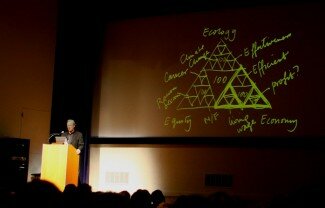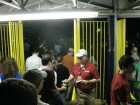Fast Company does demo job on McDonough
In a recent article in Fast Company magazine, “Green Guru Gone Wrong: William McDonough,” staff writer Danielle Sacks goes to great length— over 6,500 words, actually— to dismantle locally-based architect William McDonough’s nearly mythic status as a visionary green architect. As Sacks points out, UVA’s former “Green Dean” was Esquire’s 2005 “Big Thinker of the Year” and one of Time’s “Heroes for the Planet,” but then she proceeds to do a “demolition job” on McDonough, as Treehugger.com characterized it.
At the start of the piece, McDonough is seen palling around with the likes of Cindy Crawford, Goldie Hawn, Universal Studios president Ron Meyer, fashion designer Tom Ford, and billionaire Richard Branson, while he makes everyone swoon with his theories of a waste-free world. By the end of the piece, however, Sacks has McDonough struggling like a dolt to put up a patio umbrella at a mansion in Maine that one of his famous friends has let him use.
“Sweaty and breathless, McDonough finally flips the umbrella upside down onto the deck. “Snap this until it snaps into that,” he instructs me, pointing to a wooden lever. He is crouching over as if he were inspecting some kind of beached specimen, his hair like a tuft of grass atop a windswept rock. It’s hard not to wonder, even with Al Gore’s Hollywood engine behind him, whether this is really the man to lead the next industrial revolution. Or whether, as McDonough says, rising with a gasp, “there’s an easier way to do this.”
In between, Sacks does a considerable amount of shoe-leather reporting in an attempt to show us that that the green emperor has no clothes. For instance, when McDonough describes his work helping Nike develop an environmentally friendly materials list for its shoes as “incredible” and “inspiring,” Sacks finds a Nike exec who explains that the company parted ways with McDonough because, in addition to the large consulting fees he’d collected, he claimed his materials list was proprietary.
“He wanted to charge us for every supplier we rolled it out to. We didn’t own it after we paid all this money, which made no sense,” said the exec.
As McDonough touts a building at Oberlin College that “we designed that makes more energy than it needs to operate,” Sacks finds a Oberlin physics professor who has been monitoring the building’s energy use and says it’s drawing over 80 percent of its power from local power plants.
When McDonough explains his work with the Chinese government in Thomas Friedman’s 2006 documentary Addicted to Oil, describing specially designed “eco-cities” that will house “400 million people in 12 years,” Sacks gives us Rob Watson, founding chairman of the LEED certification program, who has worked in China for years.
“That just made me blow a gasket,” Watson is quoted, “because when that was being filmed, things were starting to go south, and [McDonough] knew it— they knew it! And they still put it on film! The whole experiment was touted as a success long after it failed. Nobody’s living there, nobody moved in. It’s sitting there, literally, rotting.”
Closer to home, McDonough’s involvement in the design of Monticello High School, which was completed in 1998, would have fit nicely into Sack’s story. In 1996, Albemarle County agreed to pay McDonough around $200,000 (which included $45,000 for a design Charrette) for his ideas on sustainable design strategies for the new $23 million high school. But when McDonough submitted the analysis, it was rejected by county schools and public works officials. “We felt the document contained too many inconsistencies and that many of the cost estimates were suspect,” said Al Reaser, director of building service, in a letter to the Albemarle County school board, according to an 1996 story in the Daily Progress. “Although a preliminary analysis has been completed, it is not acceptable. ”
So is McDonough an eco-shyster? Sacks doesn’t go quite that far, pointing out that McDonough’s Cradle-to-Cradle manufacturing theory is something the green community has universally embraced. But she strongly suggests that the architect’s desire to save the planet may be driven as equally by a desire for fame and fortune, and that those in the green community have been reluctant to call McDonough out for fear of losing one of the movement’s most influential figures.
In many ways the article is an attempt to unmask the green movement, which has created fortunes for those touting and promoting it as a way to save the planet. For instance, Fast Company reported last year that Al Gore, who founded a startup called Generation Investment Management (which invests only in green companies) and won a Nobel Peace Prize for his work on climate change, had a net worth of $100 million, compared to a net worth of $1 to $2 million before his run for the presidency in 2000. That’s alot of green for going green.
So what does McDonough think of the job done by Fast Company?
Although McDonough was unavailable for comment, his communications director, Kira Gould, responded by saying, “Obviously, we’re disappointed that Danielle Sacks decided to turn a profile of Bill into a personal attack.” Gould also said there were “several incomplete stories and inaccuracies” in Sack’s story, but did not elaborate. When asked in a follow-up email if she would elaborate, Gould said she first needed “to understand the context” of the story the Hook was working on. This reporter explained that he wanted to know what parts of the Fast Company story were incomplete and inaccurate. By press time, Gould had yet to respond.
Updated 10/30/08













The Fast Company article never said McDonough was a crook. The article did portray him as greedy, incompetent and egotistical but those aren’t crimes. The metaphorical tale of the umbrella demonstrated McDonough’s incompetence and his inability to actually bring his visions to fruition. He couldn’t put up the umbrella just like he couldn’t design and build the green village in China to meet the real needs of the rural Chinese villagers. He fumbled with the umbrella the same way he fumbled with the building at Oberlin College. The umbrella story was appropriate and telling.
I’d like to read an update of some of the local projects that he was involved with. How has Monticello High School performed? Has it done well enough to justify the huge consultant’s fee paid McDonough? The building was supposed to be designed as a model of sustainable design. Has it worked out the way it was promised to? It would be wonderful if it has.
What about the addition to UVa’s School of Architecture building, Campbell Hall, that was supposed to be built in 1998? According to articles in the local papers in 1995 the addition would be a “net exporter of energy.” What happened to that? A new addition to Campbell Hall was just dedicated yesterday, 10-25-08. Was the addition that was to be finished in 1998 never built? If not, why not? If it was built, how has it performed? The promise that the building would be a “net exporter of energy” brings to mind the story of the Environmental Studies Center at Oberlin. According to Fast Company, McDonough claimed the Center was a net exporter of energy but a professor at Oberlin did an analysis that showed “it was consuming more than twice the energy projected and drawing 84% of its power from local power plants, rather than renewable sources.”
More on cradle to cradle can be found here: http://www.product-life.org/en/cradle-to-cradle